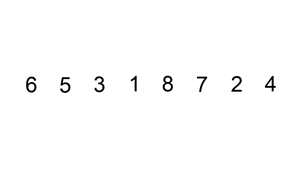Insertion sort facts for kids
In computer science, insertion sort is a simple way for computers to put things in order, like a list of numbers or words. Imagine you have a messy pile of items and you want to arrange them neatly. Insertion sort helps a computer do this one item at a time. It's like sorting a hand of playing cards: you pick up one card and put it in the right spot among the cards you already have sorted.
This method is very easy to understand and build. However, it's not always the fastest way to sort large amounts of data. Other methods, like quicksort, can be much quicker for big lists. But for small lists, or when you get new items one by one, insertion sort can be quite useful.
Contents
What is Sorting?
Sorting means putting a list of items into a specific order. This order could be from smallest to largest, largest to smallest, or even alphabetical. Computers sort information all the time. For example, when you look at a list of files on your computer, they might be sorted by name or date. When you shop online, products might be sorted by price or popularity. Sorting helps us find information much faster!
How Insertion Sort Works
Insertion sort works by building a sorted list one item at a time. It takes an item from the unsorted part of the list and "inserts" it into the correct position within the already sorted part.
Let's use an example with numbers. Imagine you have these numbers: 5, 2, 8, 1, 9.
Step-by-Step Example
1. Start with the first item: The first item (5) is considered "sorted" by itself. So, your sorted list is [5], and the unsorted list is [2, 8, 1, 9]. 2. Take the next item: Pick the next item from the unsorted list, which is 2. 3. Insert it into the sorted part: Compare 2 with 5. Since 2 is smaller than 5, it should go before 5. Your sorted list becomes [2, 5]. The unsorted list is now [8, 1, 9]. 4. Repeat for the next item: Pick 8. Compare 8 with 5. Since 8 is larger, it goes after 5. Your sorted list is [2, 5, 8]. Unsorted: [1, 9]. 5. Next item (1): Pick 1. Compare 1 with 8, then 5, then 2. Since 1 is smaller than all of them, it goes at the very beginning. Your sorted list is [1, 2, 5, 8]. Unsorted: [9]. 6. Last item (9): Pick 9. Compare 9 with 8. Since 9 is larger, it goes after 8. Your sorted list is [1, 2, 5, 8, 9]. Unsorted: [].
Now, all the numbers are sorted!
Visualizing the Process
The pictures below help show how insertion sort works.
In the image above, imagine the gray boxes are already sorted. The box labeled "x" is the next item to be inserted. The boxes labeled "≤x" are numbers smaller than or equal to "x", and "≥x" are numbers greater than or equal to "x". The goal is to put "x" in the right place between them.
After the "x" is inserted, the list becomes sorted, as shown in the image above. The "x" has found its correct spot among the other numbers.
Why Use Insertion Sort?
Even though insertion sort isn't the fastest for very large lists, it has some good points:
- Simple to code: It's one of the easiest sorting methods to write computer code for.
- Good for small lists: For lists with only a few items, it's actually quite fast.
- Efficient for nearly sorted lists: If a list is already almost in order, insertion sort can sort it very quickly.
- Online sorting: It can sort items as they arrive, one by one, without needing the whole list at once. This is useful for things like live data feeds.
Images for kids
See also
 In Spanish: Ordenamiento por inserción para niños
In Spanish: Ordenamiento por inserción para niños




